light INFINITI QX50 2021 Owner's Manual
[x] Cancel search | Manufacturer: INFINITI, Model Year: 2021, Model line: QX50, Model: INFINITI QX50 2021Pages: 542, PDF Size: 3.51 MB
Page 498 of 542
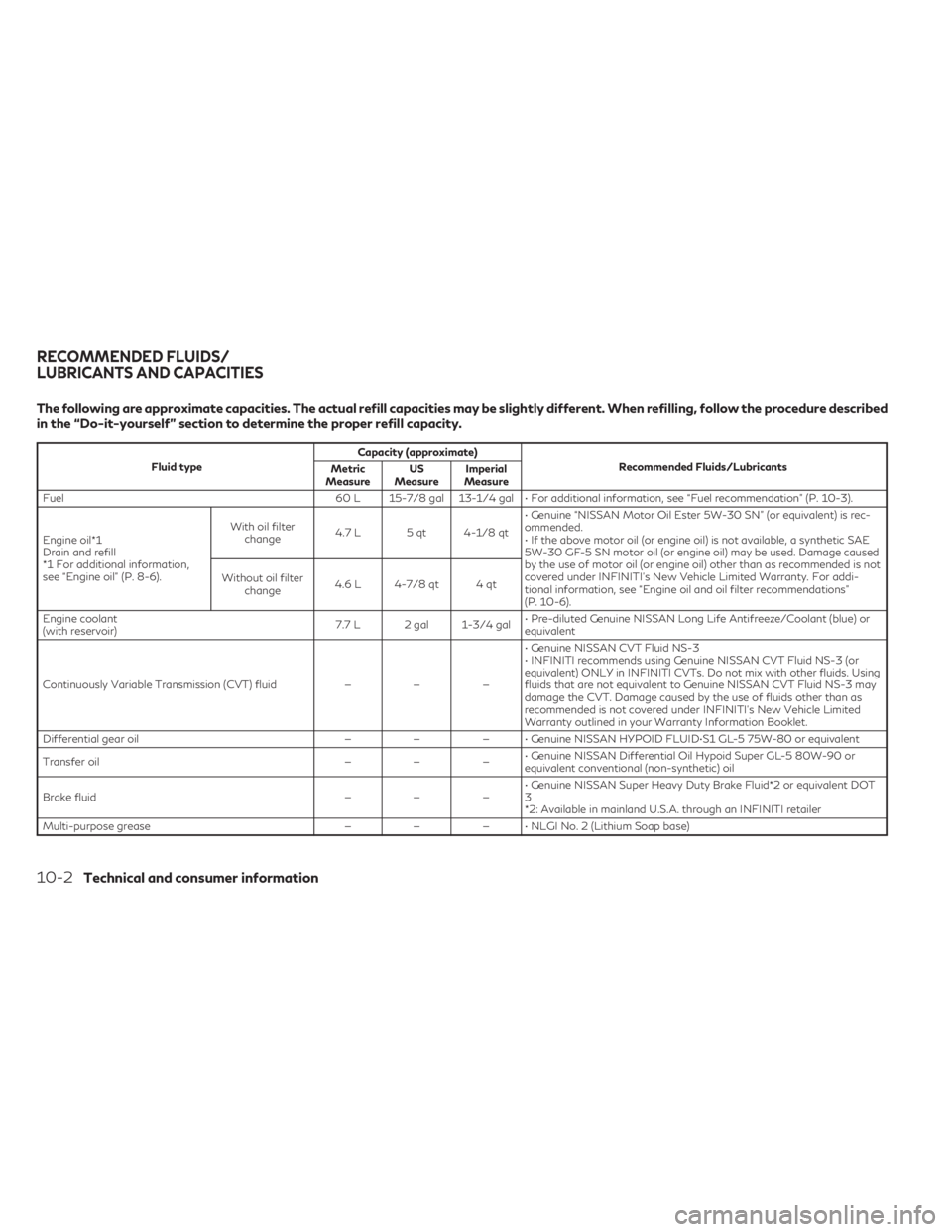
The following are approximate capacities. The actual refill capacities may be slightly different. When refilling, follow the procedure described
in the “Do-it-yourself” section to determine the proper refill capacity.
Fluid typeCapacity (approximate)
Recommended Fluids/Lubricants
Metric
Measure US
Measure Imperial
Measure
Fuel 60 L 15-7/8 gal 13-1/4 gal • For additional information, see “Fuel recommendation” (P. 10-3).
Engine oil*1
Drain and refill
*1 For additional information,
see “Engine oil” (P. 8-6). With oil filter
change 4.7 L 5 qt 4-1/8 qt • Genuine “NISSAN Motor Oil Ester 5W-30 SN” (or equivalent) is rec-
ommended.
• If the above motor oil (or engine oil) is not available, a synthetic SAE
5W-30 GF-5 SN motor oil (or engine oil) may be used. Damage caused
by the use of motor oil (or engine oil) other than as recommended is not
covered under INFINITI’s New Vehicle Limited Warranty. For addi-
tional information, see “Engine oil and oil filter recommendations”
(P. 10-6).
Without oil filter
change 4.6 L 4-7/8 qt 4 qt
Engine coolant
(with reservoir) 7.7 L 2 gal 1-3/4 gal• Pre-diluted Genuine NISSAN Long Life Antifreeze/Coolant (blue) or
equivalent
Continuously Variable Transmission (CVT) fluid —— —• Genuine NISSAN CVT Fluid NS-3
• INFINITI recommends using Genuine NISSAN CVT Fluid NS-3 (or
equivalent) ONLY in INFINITI CVTs. Do not mix with other fluids. Using
fluids that are not equivalent to Genuine NISSAN CVT Fluid NS-3 may
damage the CVT. Damage caused by the use of fluids other than as
recommended is not covered under INFINITI’s New Vehicle Limited
Warranty outlined in your Warranty Information Booklet.
Differential gear oil —— — • Genuine NISSAN HYPOID FLUID•S1 GL-5 75W-80 or equivalent
Transfer oil —— —• Genuine NISSAN Differential Oil Hypoid Super GL-5 80W-90 or
equivalent conventional (non-synthetic) oil
Brake fluid —— —• Genuine NISSAN Super Heavy Duty Brake Fluid*2 or equivalent DOT
3
*2: Available in mainland U.S.A. through an INFINITI retailer
Multi-purpose grease —— — • NLGI No. 2 (Lithium Soap base)
RECOMMENDED FLUIDS/
LUBRICANTS AND CAPACITIES
10-2Technical and consumer information
Page 501 of 542
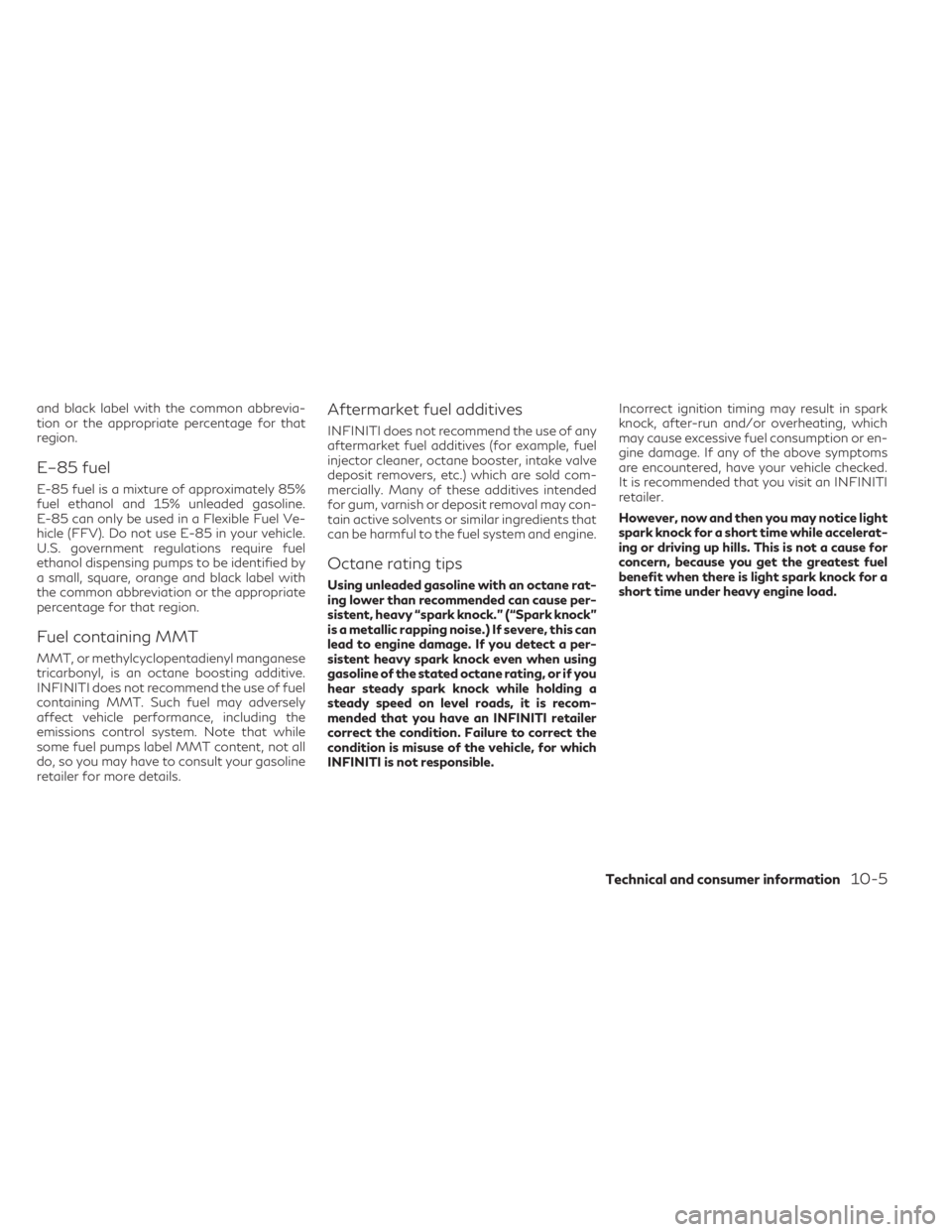
and black label with the common abbrevia-
tion or the appropriate percentage for that
region.
E–85 fuel
E-85 fuel is a mixture of approximately 85%
fuel ethanol and 15% unleaded gasoline.
E-85 can only be used in a Flexible Fuel Ve-
hicle (FFV). Do not use E-85 in your vehicle.
U.S. government regulations require fuel
ethanol dispensing pumps to be identified by
a small, square, orange and black label with
the common abbreviation or the appropriate
percentage for that region.
Fuel containing MMT
MMT, or methylcyclopentadienyl manganese
tricarbonyl, is an octane boosting additive.
INFINITI does not recommend the use of fuel
containing MMT. Such fuel may adversely
affect vehicle performance, including the
emissions control system. Note that while
some fuel pumps label MMT content, not all
do, so you may have to consult your gasoline
retailer for more details.
Aftermarket fuel additives
INFINITI does not recommend the use of any
aftermarket fuel additives (for example, fuel
injector cleaner, octane booster, intake valve
deposit removers, etc.) which are sold com-
mercially. Many of these additives intended
for gum, varnish or deposit removal may con-
tain active solvents or similar ingredients that
can be harmful to the fuel system and engine.
Octane rating tips
Using unleaded gasoline with an octane rat-
ing lower than recommended can cause per-
sistent, heavy “spark knock.” (“Spark knock”
is a metallic rapping noise.) If severe, this can
lead to engine damage. If you detect a per-
sistent heavy spark knock even when using
gasoline of the stated octane rating, or if you
hear steady spark knock while holding a
steady speed on level roads, it is recom-
mended that you have an INFINITI retailer
correct the condition. Failure to correct the
condition is misuse of the vehicle, for which
INFINITI is not responsible.Incorrect ignition timing may result in spark
knock, after-run and/or overheating, which
may cause excessive fuel consumption or en-
gine damage. If any of the above symptoms
are encountered, have your vehicle checked.
It is recommended that you visit an INFINITI
retailer.
However, now and then you may notice light
spark knock for a short time while accelerat-
ing or driving up hills. This is not a cause for
concern, because you get the greatest fuel
benefit when there is light spark knock for a
short time under heavy engine load.
Technical and consumer information10-5
Page 522 of 542

The safety chains can be attached to the
bumper if the hitch ball is mounted to the
bumper. Be sure to leave enough slack in the
chains to permit turning corners.
Trailer lights
CAUTION
When splicing into the vehicle electrical
system, a commercially available power-
type module/converter must be used to
provide power for all trailer lighting. This
unit uses the vehicle battery as a direct
power source for all trailer lights while us-
ing the vehicle tail light, stop light and turn
signal circuits as a signal source. The
module/converter must draw no more
than 15 milliamps from the stop and tail
lamp circuits. Using a module/converter
that exceeds these power requirements
may damage the vehicle's electrical sys-
tem. See a reputable trailer retailer to ob-
tain the proper equipment and to have it
installed.
Trailer lights should comply with federal
and/or local regulations. For assistance in
hooking up trailer lights, contact an INFINITI
retailer or reputable trailer retailer. Vehicles
equipped with the optional trailer tow pack-
age are equipped with a 7-pin trailer harness connector. If your trailer is equipped with a
flat 4-pin connector, an adapter will be
needed to connect the trailer lights to the
vehicle. Adapters are available at auto parts
stores and hitch retailers.Trailer brakes
Most states require a separate braking sys-
tem on trailers with a loaded weight above a
specific amount, make sure the trailer meets
the local regulations and the regulations
where you plan to tow.
Several types of braking systems are
available.
Surge Brakes -
The surge brake actuator is
mounted on the trailer tongue with a hydrau-
lic line running to each trailer wheel. Surge
brakes are activated by the trailer pushing
against the hitch ball when the tow vehicle is
braking. Hydraulic surge brakes are common
on rental trailers and some boat trailers. In
this type of system, there is no hydraulic or
electric connection for brake operation be-
tween the tow vehicle and the trailer.
Electric Trailer Brakes - Electric braking sys-
tems are activated by an electronic signal
sent from a trailer brake controller (special
brake-sensing module). Have a professional supplier of towing
equipment make sure the trailer brakes are
properly installed and demonstrate proper
brake function testing.
WARNING
Never connect a trailer brake system di-
rectly to the vehicle brake system.
Pre-towing tips
• Be certain your vehicle maintains a level position when a loaded and/or unloaded
trailer is hitched. Do not drive the vehicle if
it has an abnormal nose-up or nose-down
condition; check for improper tongue load,
overload, worn suspension or other pos-
sible causes of either condition.
• Always secure items in the trailer to prevent load shift while driving.
• Keep the cargo load as low as possible in the trailer to keep the trailer center of grav-
ity low.
• Load the trailer so approximately 60% of the trailer load is in the front half and 40%
is in the back half. Also make sure the load is
balanced side to side.
10-26Technical and consumer information
Page 523 of 542
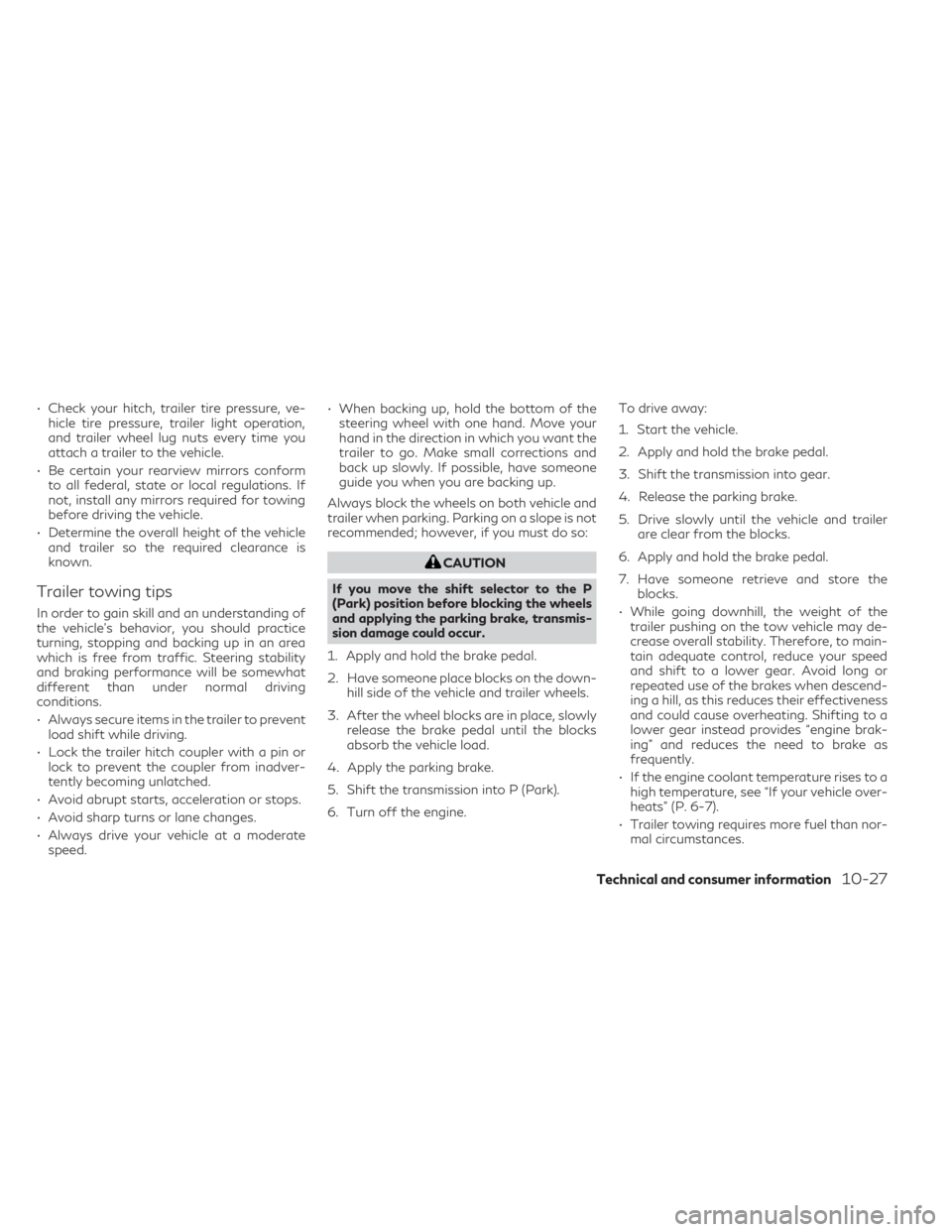
• Check your hitch, trailer tire pressure, ve-hicle tire pressure, trailer light operation,
and trailer wheel lug nuts every time you
attach a trailer to the vehicle.
• Be certain your rearview mirrors conform to all federal, state or local regulations. If
not, install any mirrors required for towing
before driving the vehicle.
• Determine the overall height of the vehicle and trailer so the required clearance is
known.
Trailer towing tips
In order to gain skill and an understanding of
the vehicle's behavior, you should practice
turning, stopping and backing up in an area
which is free from traffic. Steering stability
and braking performance will be somewhat
different than under normal driving
conditions.
• Always secure items in the trailer to preventload shift while driving.
• Lock the trailer hitch coupler with a pin or lock to prevent the coupler from inadver-
tently becoming unlatched.
• Avoid abrupt starts, acceleration or stops.
• Avoid sharp turns or lane changes.
• Always drive your vehicle at a moderate speed. • When backing up, hold the bottom of the
steering wheel with one hand. Move your
hand in the direction in which you want the
trailer to go. Make small corrections and
back up slowly. If possible, have someone
guide you when you are backing up.
Always block the wheels on both vehicle and
trailer when parking. Parking on a slope is not
recommended; however, if you must do so:
CAUTION
If you move the shift selector to the P
(Park) position before blocking the wheels
and applying the parking brake, transmis-
sion damage could occur.
1. Apply and hold the brake pedal.
2. Have someone place blocks on the down- hill side of the vehicle and trailer wheels.
3. After the wheel blocks are in place, slowly release the brake pedal until the blocks
absorb the vehicle load.
4. Apply the parking brake.
5. Shift the transmission into P (Park).
6. Turn off the engine. To drive away:
1. Start the vehicle.
2. Apply and hold the brake pedal.
3. Shift the transmission into gear.
4. Release the parking brake.
5. Drive slowly until the vehicle and trailer
are clear from the blocks.
6. Apply and hold the brake pedal.
7. Have someone retrieve and store the blocks.
• While going downhill, the weight of the trailer pushing on the tow vehicle may de-
crease overall stability. Therefore, to main-
tain adequate control, reduce your speed
and shift to a lower gear. Avoid long or
repeated use of the brakes when descend-
ing a hill, as this reduces their effectiveness
and could cause overheating. Shifting to a
lower gear instead provides “engine brak-
ing” and reduces the need to brake as
frequently.
• If the engine coolant temperature rises to a high temperature, see “If your vehicle over-
heats” (P. 6-7).
• Trailer towing requires more fuel than nor- mal circumstances.
Technical and consumer information10-27
Page 524 of 542

• Avoid towing a trailer for your vehicle's first500 miles (805 km).
• For the first 500 miles (805 km) that you do tow, do not drive over 50 mph (80
km/h).
• Have your vehicle serviced more often than at intervals specified in the recommended
maintenance schedule in “Maintenance and
schedules” (P. 9-2).
• When making a turn, your trailer wheels will be closer to the inside of the turn than your
vehicle wheels. To compensate for this,
make a larger than normal turning radius
during the turn.
• Crosswinds and rough roads will adversely affect vehicle/trailer handling, possibly
causing vehicle sway. When being passed
by larger vehicles, be prepared for possible
changes in crosswinds that could affect
vehicle handling.
Do the following if the trailer begins to sway:
1. Take your foot off the accelerator pedal to allow the vehicle to coast and steer as
straight ahead as the road conditions al-
low. This combination will help stabilize
the vehicle
– Do not correct trailer sway by steering or applying the brakes. 2. When the trailer sway stops, gently apply
the brakes and pull to the side of the road
in a safe area.
3. Try to rearrange the trailer load so it is balanced as described in this section.
• Be careful when passing other vehicles. Passing while towing a trailer requires con-
siderably more distance than normal pass-
ing. Remember, the length of the trailer
must also pass the other vehicle before you
can safely change lanes.
• Downshift the transmission to a lower gear for engine braking when driving down
steep or long hills. This will help slow the
vehicle without applying the brakes.
• Avoid holding the brake pedal down too long or too frequently. This could cause the
brakes to overheat, resulting in reduced
braking efficiency.
• Increase your following distance to allow for greater stopping distances while tow-
ing a trailer. Anticipate stops and brake
gradually.
• INFINITI recommends that the cruise con- trol not be used while towing a trailer.
• Some states or provinces have specific regulations and speed limits for vehicles
that are towing trailers. Obey the local
speed limits. • Check your hitch, trailer wiring harness
connections, and trailer wheel lug nuts af-
ter 50 miles (80 km) of travel and at every
break.
• When launching a boat, don't allow the water level to go over the exhaust tail pipe
or rear bumper.
• Make sure you disconnect the trailer lights before backing the trailer into the water or
the trailer lights may burn out.
When towing a trailer, final drive gear oil
should be replaced and transmission oil/
fluid should be changed more frequently. For
additional information, see“ Do-it-yourself”
(P. 8-2).
FLAT TOWING FOR ALL–WHEEL
DRIVE VEHICLE (if so equipped)
Towing your vehicle with all four wheels on
the ground is sometimes called flat towing.
This method is sometimes used when towing
a vehicle behind a recreational vehicle, such
as a motor home.
10-28Technical and consumer information
Page 528 of 542

WARNING
A vehicle equipped with All-Wheel Drive
(AWD) should never be tested using a two
wheel dynamometer (such as the dyna-
mometers used by some states for emis-
sions testing), or similar equipment. Make
sure you inform the test facility personnel
that your vehicle is equipped with AWD
before it is placed on a dynamometer. Us-
ing the wrong test equipment may result in
transmission damage or unexpected ve-
hicle movement which could result in seri-
ous vehicle damage or personal injury.
Due to legal requirements in some states and
Canadian Provinces, your vehicle may be re-
quired to be in what is called the “ready con-
dition” for an Inspection/Maintenance (I/M)
test of the emission control system.
The vehicle is set to the “ready condition”
when it is driven through certain driving pat-
terns. Usually, the ready condition can be
obtained by ordinary usage of the vehicle. If a powertrain system component is repaired
or the battery is disconnected, the vehicle
may be reset to a “not ready” condition. Be-
fore taking the I/M test, check the vehicle's
inspection/maintenance test readiness con-
dition. Place the ignition switch in the ON
position without starting the engine. If the
Malfunction Indicator Light (MIL) comes on
steady for 20 seconds and then blinks for 10
seconds , the I/M test condition is “not
ready”. If the MIL does not blink after 20
seconds, the I/M test condition is “ready”. It is
recommended that you visit an INFINITI re-
tailer to set the “ready condition” or to pre-
pare the vehicle for testing.
The ProPILOT Assist is equipped with an
Event Data Recording function.
The main purpose is to record, in certain crash
or near crash-like situations, such as an air
bag deployment or hitting a road obstacle,
data that will assist in understanding how a
vehicle’s systems performed. The Data re-
cording function is designed to record data
related to driver operation, vehicle dynamics
and system status for a short period of time.
The Data recording function in this vehicle is
designed to record such data as:
• Driver operational status of accelerator,
brake, handle etc.
• Detection status of a vehicle ahead and lane markers
• Vehicle information such as vehicle speed
• Information on the operation of the ProPI- LOT Assist
• ProPILOT Assist malfunction diagnosis information
• Images from multi-sensing front camera (Available only when SRS air bag or FEB
with Pedestrian Detection system is
activated)
The ProPILOT Assist does not record con-
versations, sounds or images of the inside of
the vehicle.
READINESS FOR INSPECTION/
MAINTENANCE (I/M) TEST EVENT DATA RECORDERS (EDR)
10-32Technical and consumer information
Page 531 of 542
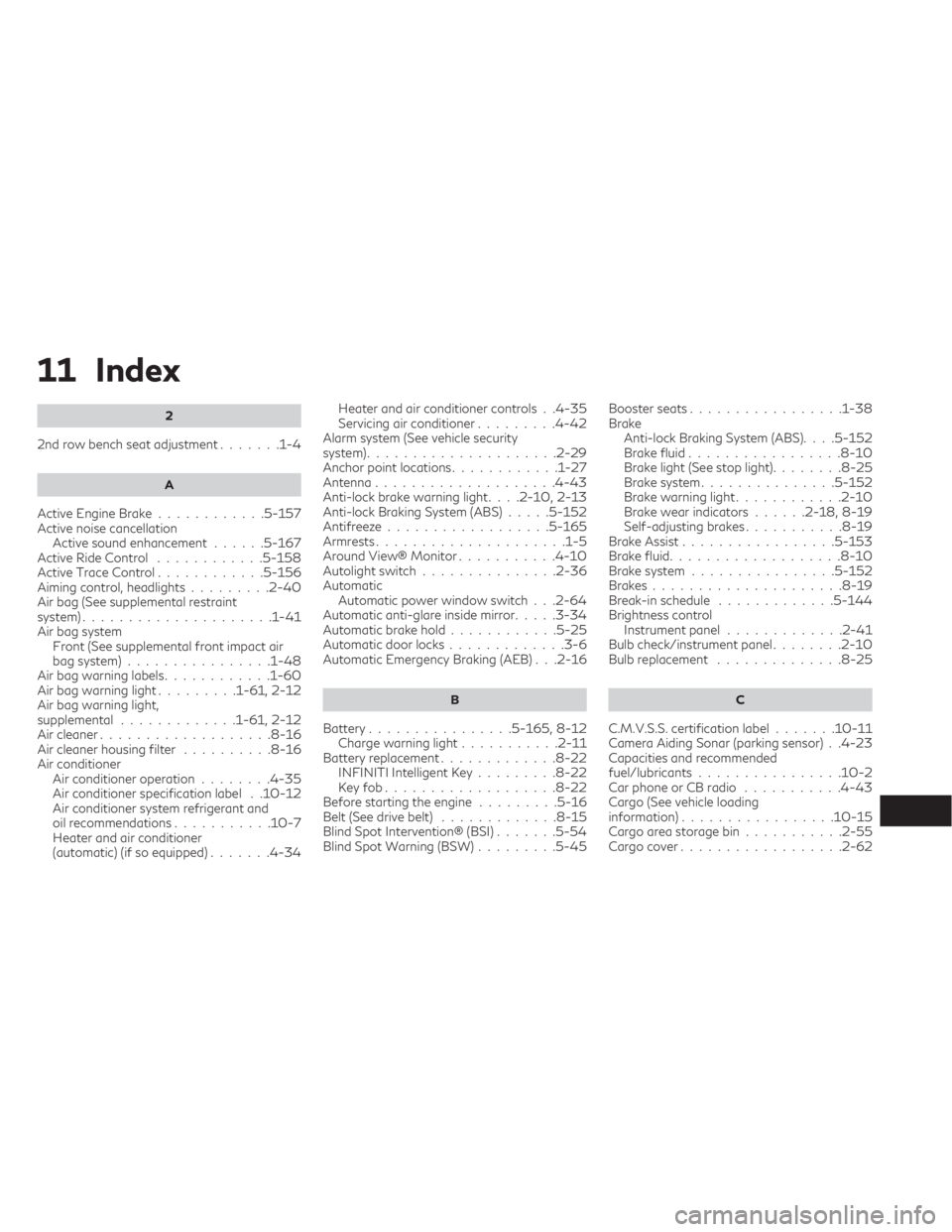
11 Index
2
2nd row bench seat adjustment.......1-4
A
Active Engine Brake............5-157Active noise cancellation
Active sound enhancement......5-167Active Ride Control........... .5-158Active Trace Control............5-156Aiming control, headlights.........2-40Air bag (See supplemental restraint
system).................... .1-41Air bag system
Front (See supplemental front impact air
bag system)
............... .1-48Air bag warning labels............1-60Air bag warning light.........1-61, 2-12Air bag warning light,
supplemental............ .1-61, 2-12Air cleaner.................. .8-16Air cleaner housing filter..........8-16Air conditioner
Air conditioner operation........4-35Air conditioner specification label. .10-12Air conditioner system refrigerant and
oil recommendations.......... .10-7Heater and air conditioner
(automatic) (if so equipped).......4-34
Heater and air conditioner controls. .4-35Servicing air conditioner.........4-42Alarm system (See vehicle security
system).................... .2-29Anchor point locations............1-27Antenna................... .4-43Anti-lock brake warning light. . . .2-10, 2-13Anti-lock Braking System (ABS).....5-152Antifreeze..................5-165Armrests.................... .1-5Around View® Monitor...........4-10Autolight switch.............. .2-36Automatic
Automatic power window switch. . .2-64Automatic anti-glare inside mirror.....3-34Automatic brake hold........... .5-25Automatic door locks............ .3-6Automatic Emergency Braking (AEB). . .2-16
B
Battery............... .5-165, 8-12Charge warning light...........2-11Battery replacement............ .8-22INFINITI Intelligent Key.........8-22Key fob.................. .8-22Before starting the engine.........5-16Belt (See drive belt).............8-15Blind Spot Intervention® (BSI).......5-54Blind Spot Warning (BSW).........5-45
Booster seats................ .1-38Brake
Anti-lock Braking System (ABS). . . .5-152Brake fluid................ .8-10Brake light (See stop light)........8-25Brake system...............5-152Brake warning light............2-10Brake wear indicators......2-18, 8-19Self-adjusting brakes...........8-19Brake Assist................ .5-153Brake fluid.................. .8-10Brake system................5-152Brakes.................... .8-19Break-in schedule.............5-144Brightness control
Instrument panel............ .2-41Bulb check/instrument panel........2-10Bulb replacement............. .8-25
C
C.M.V.S.S. certification label.......10-11Camera Aiding Sonar (parking sensor). .4-23Capacities and recommended
fuel/lubricants............... .10-2Car phone or CB radio...........4-43Cargo (See vehicle loading
information)................ .10-15Cargo area storage bin...........2-55Cargo cover................. .2-62
Page 532 of 542
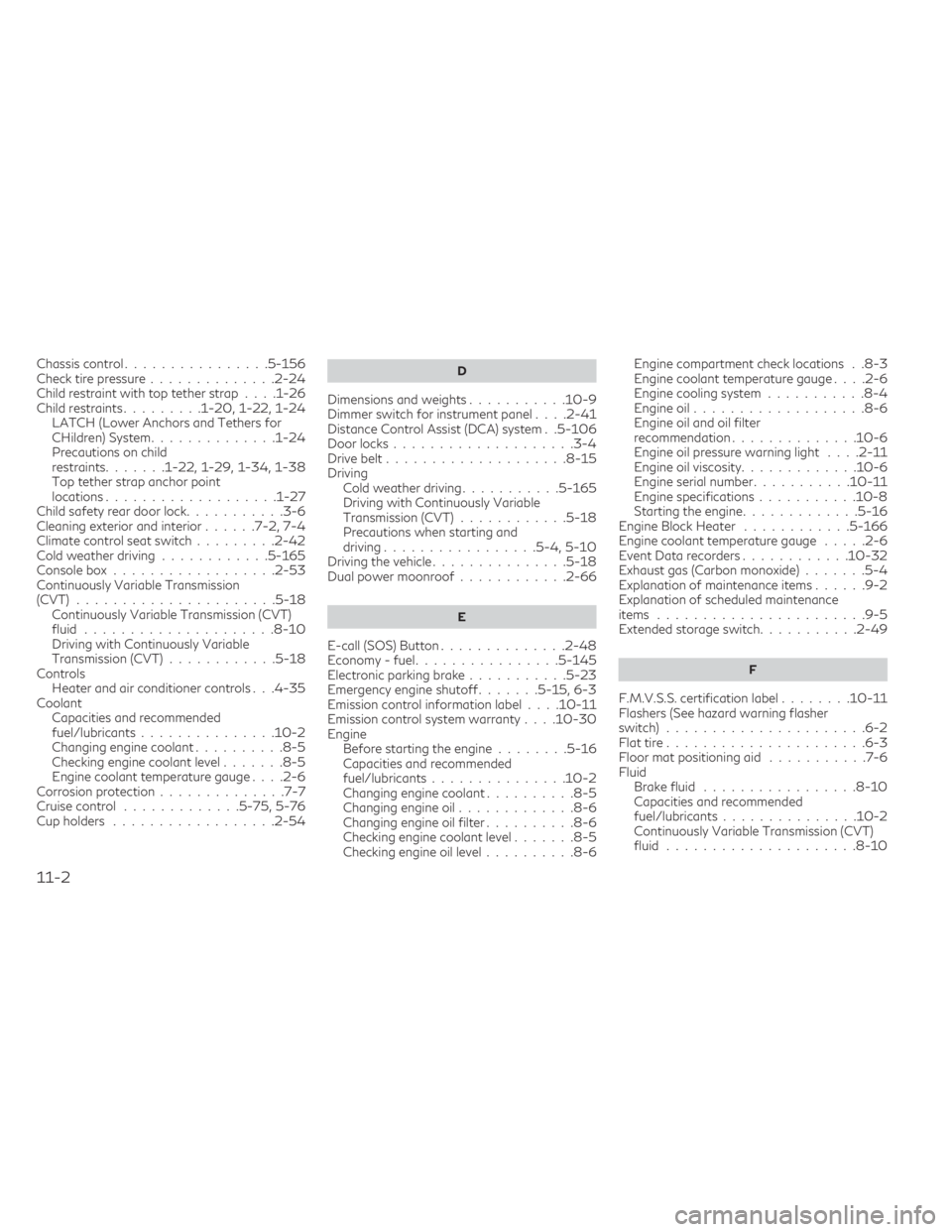
Chassis control................5-156Check tire pressure..............2-24Child restraint with top tether strap. . . .1-26Child restraints.........1-20, 1-22, 1-24LATCH (Lower Anchors and Tethers for
CHildren) System..............1-24Precautions on child
restraints.......1-22, 1-29, 1-34, 1-38Top tether strap anchor point
locations.................. .1-27Child safety rear door lock...........3-6Cleaning exterior and interior......7-2, 7-4Climate control seat switch.........2-42Cold weather driving........... .5-165Console box................. .2-53Continuously Variable Transmission
(CVT)..................... .5-18Continuously Variable Transmission (CVT)
fluid.....................8-10Driving with Continuously Variable
Transmission (CVT)............5-18Controls
Heater and air conditioner controls. . .4-35CoolantCapacities and recommended
fuel/lubricants
.............. .10-2Changing engine coolant..........8-5Checking engine coolant level.......8-5Engine coolant temperature gauge. . . .2-6Corrosion protection..............7-7Cruise control.............5-75, 5-76Cup holders................. .2-54
D
Dimensions and weights...........10-9Dimmer switch for instrument panel. . . .2-41Distance Control Assist (DCA) system. .5-106Door locks................... .3-4Drive belt....................8-15Driving
Cold weather driving.......... .5-165Driving with Continuously Variable
Transmission (CVT)........... .5-18Precautions when starting and
driving................ .5-4, 5-10Driving the vehicle...............5-18Dual power moonroof............2-66
E
E-call (SOS) Button............. .2-48Economy - fuel............... .5-145Electronic parking brake...........5-23Emergency engine shutoff.......5-15, 6-3Emission control information label. . . .10-11Emission control system warranty. . . .10-30Engine
Before starting the engine........5-16Capacities and recommended
fuel/lubricants.............. .10-2Changing engine coolant..........8-5Changing engine oil.............8-6Changing engine oil filter..........8-6Checking engine coolant level.......8-5Checking engine oil level..........8-6
Engine compartment check locations. .8-3Engine coolant temperature gauge. . . .2-6Engine cooling system...........8-4Engine oil.................. .8-6Engine oil and oil filter
recommendation..............10-6Engine oil pressure warning light. . . .2-11Engine oil viscosity.............10-6Engine serial number...........10-11Engine specifications...........10-8Starting the engine............ .5-16Engine Block Heater............5-166Engine coolant temperature gauge. . . . .2-6Event Data recorders............10-32Exhaust gas (Carbon monoxide).......5-4Explanation of maintenance items......9-2Explanation of scheduled maintenance
items...................... .9-5Extended storage switch...........2-49
F
F.M.V.S.S. certification label........10-11Flashers (See hazard warning flasher
switch)..................... .6-2Flat tire......................6-3Floor mat positioning aid...........7-6Fluid
Brake fluid................ .8-10Capacities and recommended
fuel/lubricants...............10-2Continuously Variable Transmission (CVT)
fluid.................... .8-10
11-2
Page 533 of 542

Engine coolant................8-4Engine oil.................. .8-6Windshield-washer fluid.........8-11Fog light switch................2-42Forward Emergency Braking (FEB) with
Pedestrian Detection system. . .2-13, 5-123Front air bag system
(See supplemental restraint system). . . .1-48Front and rear sonar system........5-160Front and rear sonar system switch. . . .2-45Front power seat adjustment.........1-3Front seats................... .1-2Front-door pocket..............2-50Fuel
Capacities and recommended
fuel/lubricants
.............. .10-2Fuel economy...............5-145Fuel gauge................. .2-7Fuel octane rating.............10-5Fuel recommendation...........10-3Fuel-filler door and cap..........3-28Loose fuel cap warning..........2-22Fuel efficient driving tips..........5-144Fuel gauge................... .2-7Fuel-filler door.................3-28Fuses..................... .8-20Fusible links..................8-21
G
Garage door opener, HomeLink® Universal
Transceiver.......2-70, 2-72, 2-73, 2-74Gas cap.................... .3-28
Gauge
Engine coolant temperature gauge. . . .2-6Fuel gauge................. .2-7Odometer.................. .2-5Speedometer.................2-5Tachometer................. .2-6Trip odometer................2-5General maintenance..............9-2Glove box................... .2-52Glove box lock.................2-52Grocery hooks.................2-56
H
Hazard warning flasher switch........6-2Head restraints.................1-7Head Up Display (HUD)...........2-46Headlight aiming control...........2-40Headlight and turn signal switch......2-36Headlight switch.............. .2-36Headlights.................. .8-24Headlights, aiming control..........2-40Heated seats..................2-43Heater
Heater and air conditioner (automatic)
(if so equipped)
.............. .4-34Heater and air conditioner controls. . .4-35Heater operation..............4-36Heater and air conditioner (automatic). .4-34Heater and air conditioner settings.....4-41Hill start assist system...........5-159HomeLink® Universal
Transceiver.......2-70, 2-72, 2-73, 2-74
Hood..................... .3-21Hook
Luggage hook.............. .2-55Horn...................... .2-42
I
Ignition switch
Push-button ignition switch.......5-13Immobilizer system............. .5-16Important vehicle information label. . . .10-11In-cabin microfilter..............8-16Increasing fuel economy..........5-145Indicator lights and audible reminders
(See warning/indicator lights and audible
reminders)
............... .2-9, 2-10INFINITI Drive Mode Selector.......5-28INFINITI Intelligent Key System. . . .3-2, 3-6INFINITI InTouch™ Owner's Manual. . . .4-2INFINITI Vehicle Immobilizer
System..............2-30, 3-4, 5-16Inside automatic anti-glare mirror. . . . .3-34Instrument brightness control........2-41Instrument panel.............0-6, 2-2Instrument panel dimmer switch......2-41Intelligent All-Wheel Drive (AWD). . . .5-146Intelligent Cruise Control (ICC)
(for vehicles with ProPILOT Assist). . . .5-87Intelligent Key system
Key operating range............ .3-8Key operation............... .3-9Mechanical key................3-3Remote keyless entry operation.....3-13
11-3
Page 534 of 542
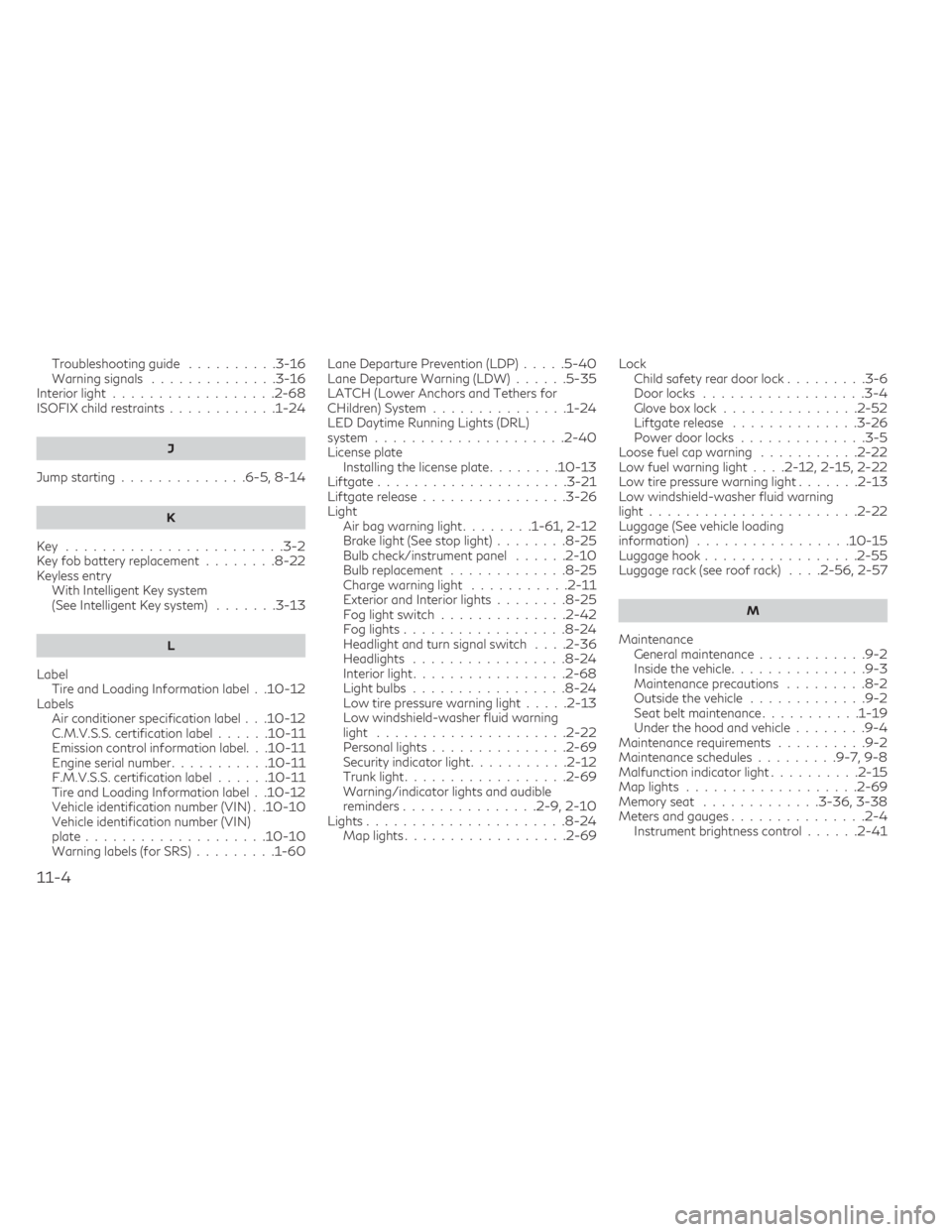
Troubleshooting guide..........3-16Warning signals..............3-16Interior light................. .2-68ISOFIX child restraints............1-24
J
Jump starting............. .6-5, 8-14
K
Key....................... .3-2Key fob battery replacement........8-22Keyless entry
With Intelligent Key system
(See Intelligent Key system)
.......3-13
L
LabelTire and Loading Information label. .10-12LabelsAir conditioner specification label. . .10-12C.M.V.S.S. certification label......10-11Emission control information label. . .10-11Engine serial number.......... .10-11F.M.V.S.S. certification label......10-11Tire and Loading Information label. .10-12Vehicle identification number (VIN). .10-10Vehicle identification number (VIN)
plate................... .10-10Warning labels (for SRS).........1-60
Lane Departure Prevention (LDP).....5-40Lane Departure Warning (LDW)......5-35LATCH (Lower Anchors and Tethers for
CHildren) System...............1-24LED Daytime Running Lights (DRL)
system.................... .2-40License plate
Installing the license plate........10-13Liftgate.................... .3-21Liftgate release................3-26Light
Air bag warning light........1-61, 2-12Brake light (See stop light)........8-25Bulb check/instrument panel......2-10Bulb replacement............ .8-25Charge warning light...........2-11Exterior and Interior lights........8-25Fog light switch............. .2-42Fog lights................. .8-24Headlight and turn signal switch. . . .2-36Headlights.................8-24Interior light.................2-68Light bulbs.................8-24Low tire pressure warning light.....2-13Low windshield-washer fluid warning
light.................... .2-22Personal lights...............2-69Security indicator light...........2-12Trunk light................. .2-69Warning/indicator lights and audible
reminders...............2-9, 2-10Lights..................... .8-24Map lights..................2-69
Lock
Child safety rear door lock.........3-6Door locks................. .3-4Glove box lock...............2-52Liftgate release..............3-26Power door locks..............3-5Loose fuel cap warning...........2-22Low fuel warning light. . . .2-12, 2-15, 2-22Low tire pressure warning light.......2-13Low windshield-washer fluid warning
light...................... .2-22Luggage (See vehicle loading
information).................10-15Luggage hook.................2-55Luggage rack (see roof rack). . . .2-56, 2-57
M
Maintenance
General maintenance........... .9-2Inside the vehicle.............. .9-3Maintenance precautions.........8-2Outside the vehicle.............9-2Seat belt maintenance...........1-19Under the hood and vehicle........9-4Maintenance requirements..........9-2Maintenance schedules.........9-7, 9-8Malfunction indicator light..........2-15Map lights.................. .2-69Memory seat.............3-36, 3-38Meters and gauges.............. .2-4Instrument brightness control......2-41
11-4